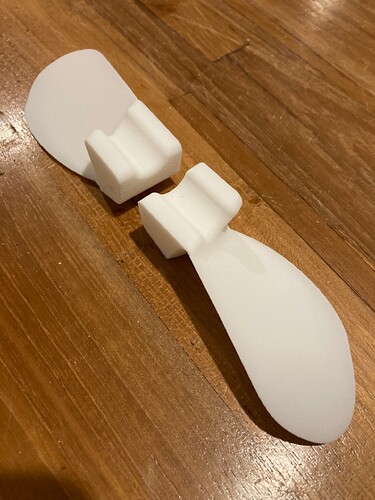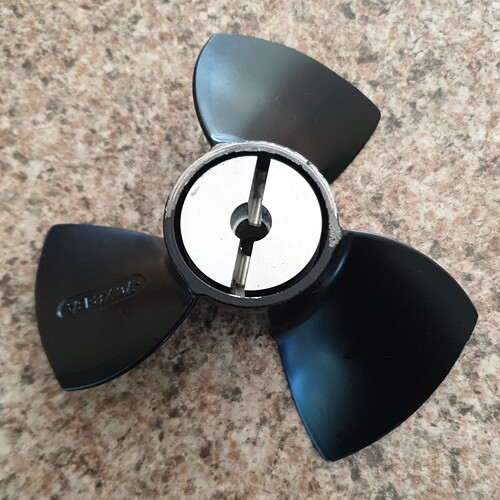The high aspect 10:1 wings like the Axis 999 are very power efficient and generate lift from low speeds.
An higher aspect wing will generate more lift for the same surface than a medium aspect so if you already have too much lift with the 1300cm aim for something arround 900-1000 as suggested by Jatem. Best to try
thank you Dynamik, yes it’s a good idea too, then you have to glue but you have to find a good glue, do you have an idea for the glue!
If you don’t do the first step (using a press to extrude the grooved brass sleeve), it’s premature to talk about a suitable adhesive. You may not even need to use glue if you use the same method to mount the propeller, which can be understood here True Glide Propeller | Fliteboard™ Australia . In other words, it will depend on how you use the v1 propeller, what material it is, the shape of the hub, etc.
Best would be to take the rubber hub out, get a part turned from aluminium, tig weld it, re face and balance. Glue usually don’t last long. On aluminium JB weld pretty good otherwise an industrial epoxy glue.
Thanks to a good samaritan, and the power of CC, the models are back up on Thingiverse.
Would be interesting to experiment around it!
I’ve printed a set of the props in SLS nylon.
Nice smooth finish.
Cost $15 per prop with a commercial printer.
SLS would indeed be great for making those blades, as otherwise, the presence of supports typically means that the surface finish is rough and needs epoxying/sanding or some kind of time consuming treatment.
Being small parts makes it affordable to get them made by professional outfits, while the chunky hub itself can be printed at home in less refined material
Why not rotate the blade and print standing?
what about making a negative mold in epoxy resin/fiber glass and make the propellers out of carbon?
You’re right, I assumed that the print would be stronger like that, and weaker along the Z axis, but that’s just an assumption, and I’m not at any testing stage to see if there’s any truth to it or not. Not even sure I’d end up with this type of prop. Just printed one in PLA+ for now, for tinkering purposes.
And there’s plenty of wind and waves at the moment for some good old fashioned foiling to delay whatever side project I have in mind.
Just an idea of mixed technology folding propeller. As 1-3d printed folding blades tend to break easily 2-since CNC time is costly and 3- it is easier to mold two or three small alu parts rather than a big prop…
@jeffM, do you think you could mold a pair of small foldable quality prop blades with your aluminium casting process ? I have moulded blades in mind mounted on a 3D printed hub, if it can resist to repeated ‘violent’ blade openings. If not the hub could also be moulded in aluminium. Then comes the delicate step of balancing.

Pict credit to @Foil_A_Lot
If the violent blade opening is causing failure, could we add a pad of damping material to soften the blade opening, much like the Flexo-drive folding boat propellors use?
I haven’t seen much information on whether people have tested non-brittle filaments for the folding blades such as nylon+glass, or even PLA-ST (which has much higher impact toughness than PLA/PLA+ which are both known to be very brittle).
My assumption. Worth a try and easy to implement … especially if boats are already using this to dampen the opening shock impact supposedly detrimental to folding blade life duration.
Some interesting figures comparing toughness of ePLA-ST compared to regular PLA:
- Elongation at break for PLA-ST is 90%. Regular PLA is 5%, PLA+ is 29%. PLA-ST is much less brittle.
- Izod Impact Strength (receiving a sharp blow): PLA-ST absorbs 63 KJ/m2, where regular PLA is only 4.2 KJ/M2 and PLA+ is 7 KJ/M2. ePAHT-CF absorbs 12.74 KJ/M2 (nylon with carbon fibre). PETG is around 8 KJ/M2. Therefore PLA-ST is 10x as impact tough as other PLA filament.
- The bending strength of PLA-ST is 44 MPa, compared to PLA 90 Mpa and PLA+ 75 MPa, so it’s not as strong overall.
If it is the impact/shock of the propellor opening that breaks it, then PLA-ST might be a lot more durable. It’s not very expensive, I’ll probably give it a try when I put together my assist build.
The problem with aluminum casting is the thickness of the blades. it is difficult to have a good result if the thickness is less than 2.5 mm
This problem of the aluminium casting (mnimal thickness of 2.5 mm) can be easily eliminated by first casting the blade in a rough shape, then precisely machining this rough casting on a CNC mill. I believe this technology of making a folding propeller is commonly used. I guess the hardest part would be finding someone in the EU to produce such castings.
Would be as easy to mill the blade from a bloc. Never easy to register on a cast. Also an aluminium cast will never have the mechanical property of a part milled from a billet
I would also like to clarify that propeller casting (and any subsequent precision machining on a CNC mill, if necessary) has been used, I believe, for many decades for 99% of all propellers produced in the world (except for RC model propellers). And it’s made of every kind of metal alloy that comes to mind - aluminum alloys, bronze alloys, steel alloys, … In addition, it is also worth considering that separate blades for the folding propeller (for e-foil propulsion) can be successfully made from high quality plastic, simply by casting without pressure. In this case, it is possible to produce the mould very accurately and very cheaply, e.g. using a 3D printer.
any updates on the testing of this optimized prop?



